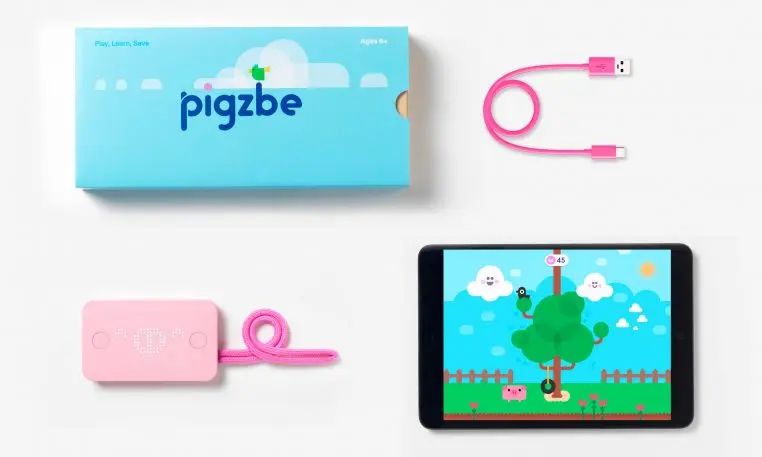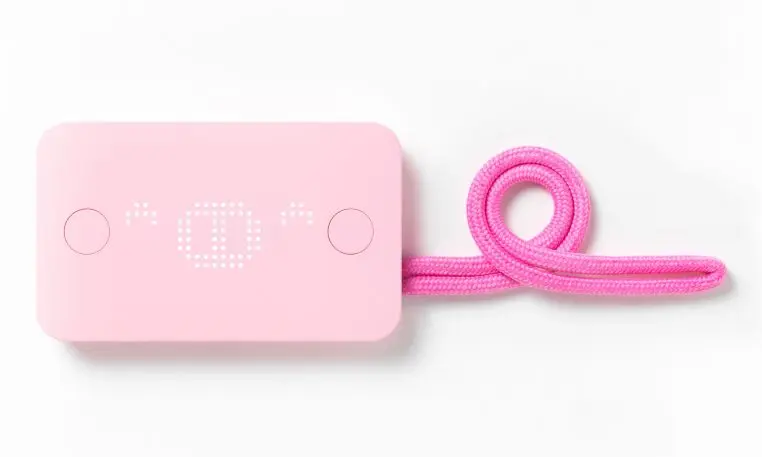When I was a kid, I counted my allowance in dimes, quarters, and dollars, hidden away in a very Breaking Bad-style stash in my desk. It was never much, but I knew what it was worth. Now that I’m a father myself, I can barely remember the last time I held cold hard cash. So how will I teach my kids the value of money, and that it literally hurts to spend it, as they grow older? Do I just Venmo them and pray they don’t get addicted to the convenience of credit?
Pigzbe is the sort of product made for just my demographic, or more specifically, my children. Designed by Primo Toys–makers of the mega-successful physical programming toy Cubetto–in conjunction with Pentagram Partner Jon Marshall, Pigzbe is essentially a digital piggy bank with a whole lot of bells and whistles. The bright pink, app-enabled digital wallet launches on Kickstarter today, starting at $79, with plans to ship this June. It allows a small group of parents and relatives to contribute very small amounts of money–as small as a penny–into a shared account through a smartphone app.
Whereas PayPal charges 30¢ to move a dollar, Pigzbe charges next to nothing.”You’re encouraged to send smaller amounts more frequently,” says Filippo Yacob, founder of Primo Toys. One small caveat: Pigzbe depends on a proprietary cryptocurrency to accomplish this feat.

Parents can set the Pigzbe app to auto-pay kids an allowance each week, and children can ask for payments for individual chores. Fun-sized capitalism? A primer for competing in the gig economy as an adult? Sure. Pigzbe is very much structured around the idea of working for a reward, perhaps at the risk of making the smallest domestic task a billed job.
As money comes in through the app, it blooms from an abstract number into an ever-growing tree, visualizing the power of savings. It also glows as a push notification on the Pigzbe wallet, a little pink LED device that can fit in a child’s pocket. A pig nose pops on the screen now and again, and the device beeps and boops when money is added through the app. The wallet has two buttons for simple functions, evoking a video game controller. And it even has a magnet to stick to the family’s refrigerator.
It’s a design that feels childlike, sure, but in a fun, self-aware way, almost like a Tamagotchi.
“Connected piggy banks exist, but by and large they’re quite toylike and large. It wasn’t immediately obvious it shouldn’t be like that. We tested some devices that looked more like pigs and toys, and the feedback we got from kids themselves was, it had to grow with them from 6 to 12,” says Marshall. “Piggy banks are big objects because they hold physical money, and connected piggy banks are big because they didn’t rethink it. So we went to a form factor like a credit card or smart home product.”
All of this allows Pigzbe to solve two of the biggest problems with giving kids money today: It lets you transfer tiny amounts digitally, and it makes the digital currency appear a bit more physical. Furthermore, Pigzbe’s creators insist that they won’t track or share your child’s individual financial data–though it will collect some anonymized information for its own product improvements.
There’s a catch, though, and a big one at that: To make all of this micro-money transferring possible, Pigzbe isn’t transferring real money. It has you buy into a Pigzbe-specific currency dubbed Wollo, which is a cryptocurrency, much like bitcoin, constructed on top of the Stellar standard. (Don’t feel stupid. No normal human being has heard of Stellar, either.)
You can still buy real things with Pigzbe; the app will actually include its own marketplace of toys and other things kids might want. (The details on this are slim, but the company is developing brand partnerships for just this purpose.) Pigzbe funds can also be spent at regular stores with a specialized Visa card, which can be ordered separately. You can also, crucially, cash out Wollo for real money in the app. Down the line, I gathered that Primo Toys would like you to be able to make payments at brick-and- mortar stores directly with the pink Pigzbe wallet itself, using NFC–which would probably make the most sense both practically and in terms of teaching children the value of money.

Cryptocurrency may be the future of finance, but proposing a child or family deal exclusively in crypto, today, seems speculative at best and risky at worst. Especially since Wollo’s value isn’t fixed; it’s in flux.
“Wollo, like any other currency in the world, can go up and down in price,” Primo Toys confirms later on email. “We believe that price fluctuation is an important financial concept to learn (the dollar does it, the pound does it), so introducing children to this idea with very small amounts of money is a useful lesson.”
Perhaps it is a useful lesson that the Nintendo Switch you could afford with all that Wollo yesterday is now only worth a used Wii today. But there’s another lesson that kids should learn, too: You don’t place all your eggs in one basket. Especially if those eggs are wrecking our planet and have no intrinsic value.
Recognize your company's culture of innovation by applying to this year's Best Workplaces for Innovators Awards before the extended deadline, April 12.
